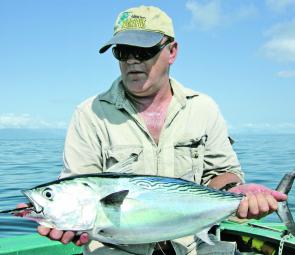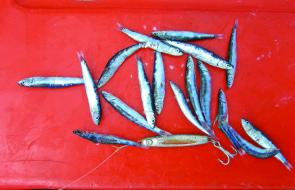The new year fishing continues to be good with fine and hot conditions and very little rain to speak of at this stage, however the wet season should not be too far away. There has generally been some good fishing action both inshore and offshore in most of the local areas. There have been some slow days, typical of this time of year coinciding with hot conditions, little run in the water, or an abundance of coral spawn.
This month we should expect to see some quality coral trout fishing. I would also recommend taking any opportunities to try some night fishing for red emperor or large mouth nannygai. These popular, targeted fish are usually found in the deepwater rubble bottom, between the reefs in water from about 45-50m in depth and beyond.
Offshore on the top water, you should find tuna, as well as a few straggler mackerel, some big barracuda, cobia and GT and of course summer also means plenty of sharks to spice up your day.
Inshore there are good mangrove jacks to chase amongst the sticks and some prime fingermark in both the deeper structure as well as the coastal headlands. Along the beaches and in estuaries there should continue to be both types of salmon for taking and of course summer is an ideal time to chase the grunter along the esplanade flats out from Cairns.
The last trip I had out prior to this article, consisted of a journey out to explore McCulloch Reef. The reef is located wide of Gibson Reef to the south of Cairns and accessed out through Russell Heads. The day started out very nicely with flat calm conditions making for a smooth comfortable ride in Col Uphams’ 16ft Stessyl. Our plan was to have a look at the large lagoon in the middle of McCulloch Reef on the low tide and go searching via a dive for a few crays and whatever else turned up and maybe also scare a few GT with some poppers.
McCulloch Reef is about 26nm east from the river mouth and along the way we found heaps of mack tuna schools which were pretty hard to bypass. Our journey out saw us catching numerous mack tuna, that were feeding hungrily on the large schools of tiny pilchards. The action was easy to pick from a distance as the bird activity hovered above the foaming top water feeding frenzy created by the tuna.
Even though the fish were aggressively feeding, once the boat cruised within casting distance, as usual we only got a couple of casts before the school moved on. We were casting small metal slices using medium spin outfits about 1.8m in length (mine was a 6-10kg Berkeley Dropshot – Tropical Spin) and I had an oldish Shimano Ultegra 3000 spooled with 20lb braid. Cols outfit was similar – a pacific composite with a brand new Shimano spin reel. These outfits were ideal as we were easily able to cast the small slices 50m or so and rip them in fast enough to instigate a strike. My small 3000 reel was singing when hooked up but still had plenty of drag strength to subdue the 5kg mack tuna in about 10 minutes. These fish were a lot of fun.
One of the most challenging tasks with these surface feeding fish is picking the right lure. Colin had one hooked up and in the boat very early and as the fish came aboard it promptly regurgitated a bunch of the small pilchards it was feeding on. This made it very easy to select a matching metal slice to closely resemble their food. Once you have a lure that closely matches the baitfish you can then concentrate on working with the wind and current to gain the optimum boat positioning for casting to the school. We find approaching up wind of the school and drifting on to them to be effective in gaining maximum distance with the cast and giving you the time for a second, or, if you are lucky a third cast at the fish. It is important to motor at speed towards the school and be ready to cast as the boat arrives. There are days of course when you are lucky and the fish are not easily spooked by your presence.
When you cast to a feeding school there is certainly a high level of expectation as your lure lands in the boil and you rip it back to the boat. The action can be thick and fast as sometimes you hook up, drop off and then hook up again several times in the one retrieve. There can be double or even triple hook ups sometimes, but not on this particular day. These fish make long runs and fight deep and will fully load up your rod with their power.
Our fun with the tunas distracted us from the rising east-southeast, which had blown up to about 18knots and made for a less than ideal long run home. The only consolation on this occasion was the breeze was behind us, but the confused swell in the 16ft boat still managed to present us with an uncomfortable bumpy ride home.
Till next month, good fishing.
Reads: 3699
Col Upham holds up a beautiful Cairns bonito (tuna) of about 4kg taken on a small slice. These fish with their speedy, powerful capabilities are great fun for any angler on medium spin gear.

Can you spot the metal slice amongst these 6cm baby pilchards that were coughed up by the feeding mack tunas?




